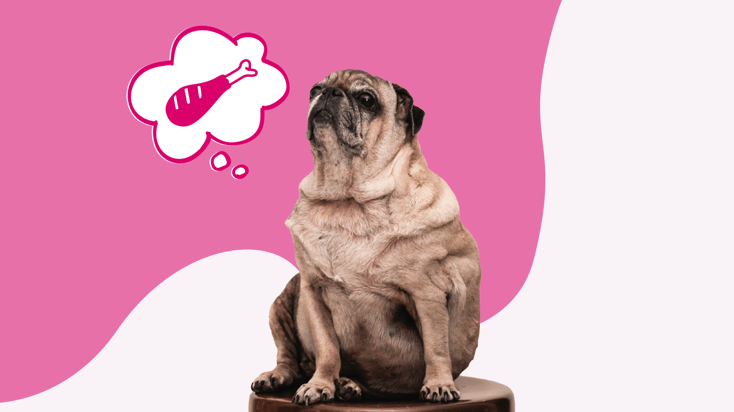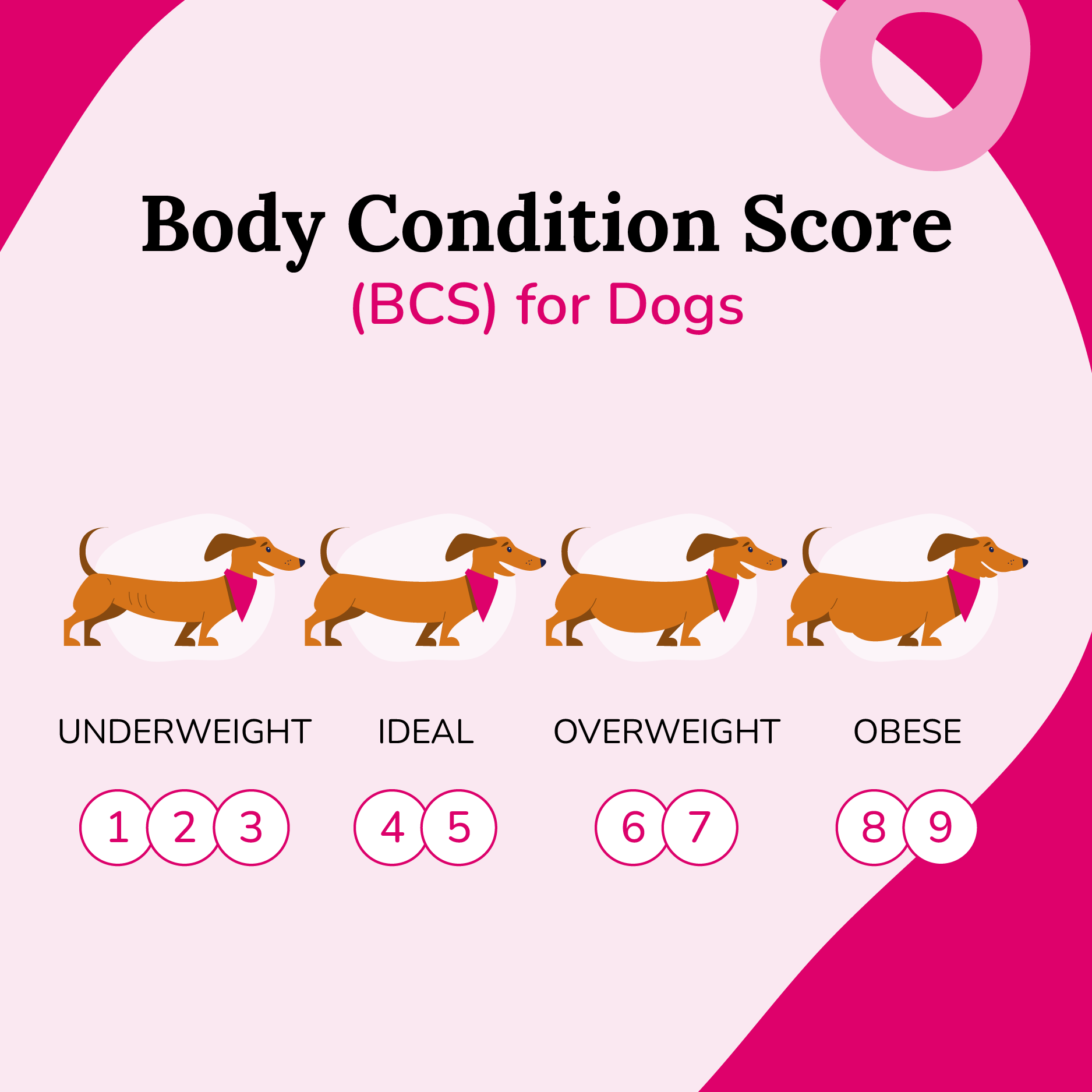Is My Dog Overweight? 7 Ways to Help

Table of Contents
In the battle against canine obesity, the numbers speak for themselves. According to the Association for Pet Obesity Prevention's estimate in 2018, 56% of dogs are classified as overweight or obese. It's time for us as pet owners to take action.
Keeping our dogs at a healthy weight is vital in preventing issues like osteoarthritis, diabetes, heart disease, and even cancer.
However, determining whether our canine friends are carrying a few extra pounds can sometimes be challenging, especially when we're unsure of the telltale signs.
Let’s explore some standard methods to assess if our dog is overweight and help you understand these indicators so that you can provide them with the care they need.
Key Takeaways:
- Obesity in dogs refers to an excessive accumulation of body fat and can lead to various health problems.
- Body condition scoring is a useful tool to assess a dog's weight and muscle mass.
- Consulting with a veterinarian is essential for personalized advice and a weight management plan.
What is Obesity in Dogs?
Canine obesity refers to an excessive accumulation of body fat in dogs, which can lead to various health problems and reduced quality of life. According to studies conducted by the Association for Pet Obesity Prevention, dogs are considered obese when their weight exceeds 30% of the ideal weight for their breed and size.
Several factors contribute to dog weight gain, including overfeeding, lack of exercise, genetic predisposition, hormonal changes associated with spaying or neutering, and certain medical conditions.
Certain breeds, such as Cairn Terriers, Basset Hounds, English Bulldogs, and Labrador Retrievers, have shown a predisposition to obesity, while others, like sighthounds, appear to be more resistant. Age-related changes in activity level and lean body mass can also influence a dog's weight.
Why It’s Important to Know Your Dog’s Ideal Weight?
Determining the ideal weight range for dogs is essential in ensuring their overall health and vitality. The ideal weight for dogs can vary depending on their breed, size, and individual characteristics.
Certain breeds may have specific considerations when it comes to weight. For example, smaller breeds like Chihuahuas generally have a lower ideal weight range due to their petite size, typically ranging from 4 to 6 pounds.
On the other hand, larger breeds like Labrador Retrievers may have a broader range, typically falling between 55 to 80 pounds. It's important to remember that individual differences within breeds can also affect a dog's weight. Factors such as muscle tone, body shape, metabolism, and activity level should be taken into account.
Do you need help determining the right amount of food your dog should eat each day? Take our quiz to guide you in estimating the appropriate portion sizes based on your dog’s current and ideal weight.

Symptoms & Signs of an Overweight Dog
Symptoms of moderately overweight dogs include:
- Excessive body fat, particularly around the ribs, hips, and neck.
- Difficulty breathing, leading to excessive panting or breathlessness.
- Reduced stamina, making it challenging to engage in physical exercise.
- Joint problems, such as hip dysplasia or arthritis, due to the strain on joints.
- Reduced mobility, difficulty climbing stairs or running.
- Digestive issues, including constipation, diarrhea, and bloating.
- Changes in behavior, such as irritability or sadness.
- Increased risk of injury, as excess weight strains muscles and joints.
- Increased thirst and urination, potentially due to the added stress on organs.
If you notice any of these symptoms in your dog, it's important to seek nutritional advice from a veterinarian. A professional evaluation from a veterinarian can help determine the underlying causes of your dog's weight gain and provide personalized recommendations for a balanced and effective weight loss plan.
Using Body Condition Scoring Chart
Body condition scoring is a valuable tool used by veterinarians to assess a dog's weight and muscle mass. It involves evaluating specific criteria, such as the dog's ribs, waistline, and overall body shape, to determine their body condition score (BCS) or body mass index (BMI).
Various scoring systems are commonly used, including a 5-point scale or a 9-point scale, each with their own descriptions of ideal, overweight, and underweight body conditions.
On a scale of 5, an ideal BCS is a 3, indicating that the dog has a healthy weight with ribs that can be felt easily.
On a scale of 9, dogs should be at a 4 or 5, where they have a defined waistline and are neither too thin nor overweight.
Start by feeling the ribs, as they should be easily felt without excessive fat covering. Then, observe the waistline to determine if it's visible or well-defined. Finally, you should note an “abdominal tuck” when viewing your dog from the side.
Vet Care at Your Fingertips With Video Consultations
Get the care your pet needs with no hassle and same-day appointments. Say goodbye to busy waiting rooms and hello to a relaxed and low-stress experience.
Overweight Dog Health Risks
Obesity in dogs can give rise to a range of serious health conditions, including
- Diabetes, skin problems
- Cushing’s disease
- Heart problems, high blood pressure
- Canine arthritis, joint problems
- Breathing problems
- Kidney disease, liver problems, certain cancers
Obesity-related health issues in dogs can have serious consequences, compromising their overall well-being and shortening their lifespan. However, by shedding excess weight, dogs can actively mitigate or even reverse these conditions, leading to a healthier and longer life.
How to Help an Overweight Dog
Here are some tips and strategies to help you manage your overweight dog's weight:
1. Consult with your veterinarian
Start by seeking guidance from your veterinarian to determine the appropriate weight loss goals and create a customized plan for your dog.
2. Adjust their diet
Transition your dog to a balanced, portion-controlled diet suitable for weight loss. Measure their food carefully and consider incorporating high-quality, low-calorie options.
Related reading: 5 Dog Food Ingredients to Look For & Ones to Avoid
3. Control feeding portions
Avoid free-feeding and, instead, divide your dog's daily food into a morning and an evening portion. This helps prevent overeating and promotes a more regulated eating schedule.
4. Monitor treats and snacks
Be mindful of the treats and snacks you give to your dog. Opt for low-calorie options or replace treats with healthier alternatives like steamed or raw vegetables safe for dogs, like celery, carrots, or green beans.
5. Increase exercise
Gradually increase your dog's physical activity by incorporating daily walks, playtime, or interactive games. Engaging in regular exercise helps burn calories and promotes weight loss.
6. Avoid table scraps
Refrain from feeding your dog table scraps or sharing your own meals. Human food can be high in calories and may contribute to extra weight gain.
7. Regular veterinary checkups
Make it a habit to schedule routine check-ups with your veterinarian to assess your dog's body condition score and overall physical well-being. Regular check-ups play a crucial role in the early detection of potential health concerns and preventing their progression.
Healthy Weight, Happy Dog
Dog obesity is no small matter, as it can lead to various health issues that compromise our furry friends' vitality and happiness. From diabetes to joint problems, the consequences are far-reaching. However, by recognizing the signs of obesity, regularly assessing our dog's body condition, and taking action, we can make a significant difference in maintaining a healthy weight.
Remember, consulting with a veterinarian is the key to tailor-made nutritional advice and creating a weight management plan that fits our dog's needs.
Should My Pet Be Seen by a Veterinarian?
1. Have you noticed changes in your pet’s appetite?
2. Does your pet have diarrhea or loose stools?
3. Have you noticed changes in your pet’s thirst/water consumption?
4. Is your pet having accidents in the house?
5. Is your pet pacing and unable to settle?
6. Is your pet panting more than usual?
7. Is your pet whining or vocalizing more than usual?
8. Is your pet shaking more than usual?
9. Is your pet hiding or avoiding physical contact more than usual?
10. Is your pet more lethargic and sleeping more than usual?
11. Are you concerned about changes in your pet’s behavior?
12. Is your pet scratching their ears?
13. Is your pet licking their paws more than usual?
14. Does your pet have a rash?
15. Is your pet moving more slowly than usual or having a harder time getting up or down?
View Results
Should My Pet Be Seen by a Veterinarian?
1. Have you noticed changes in your pet’s appetite?
2. Does your pet have diarrhea or loose stools?
3. Have you noticed changes in your pet’s thirst/water consumption?
4. Is your pet having accidents in the house?
5. Is your pet pacing and unable to settle?
6. Is your pet panting more than usual?
7. Is your pet whining or vocalizing more than usual?
8. Is your pet shaking more than usual?
9. Is your pet hiding or avoiding physical contact more than usual?
10. Is your pet more lethargic and sleeping more than usual?
11. Are you concerned about changes in your pet’s behavior?
12. Is your pet scratching their ears?
13. Is your pet licking their paws more than usual?
14. Does your pet have a rash?
15. Is your pet moving more slowly than usual or having a harder time getting up or down?
Share Quiz
Frequently Asked Questions
Why is my overweight dog always hungry?
An overweight dog may always feel hungry due to improper portion control, psychological factors, such as stress or learned behavior, or a medical issue, such as inadequate nutrition or underlying health conditions.
What is the fastest way for a dog to lose weight?
The fastest way a dog can lose weight is by controlling calorie intake and increasing exercise. Consult your veterinarian for a balanced diet plan and ensure regular exercise. Monitor progress and make adjustments as needed.
What can I feed my overweight dog to lose weight?
Feed your overweight dog a balanced, low-calorie diet recommended by your vet. Choose high-quality, weight-loss dog food and limit high-calorie treats. Monitor portions and track their progress.
Can dogs die from being overweight?
Yes, overweight dogs can face life-threatening risks. Obesity increases the chances of diabetes, heart disease, and certain cancers. Even moderate excess weight can shorten a dog's lifespan by up to two years. Managing their weight is essential for their overall health and longevity.







